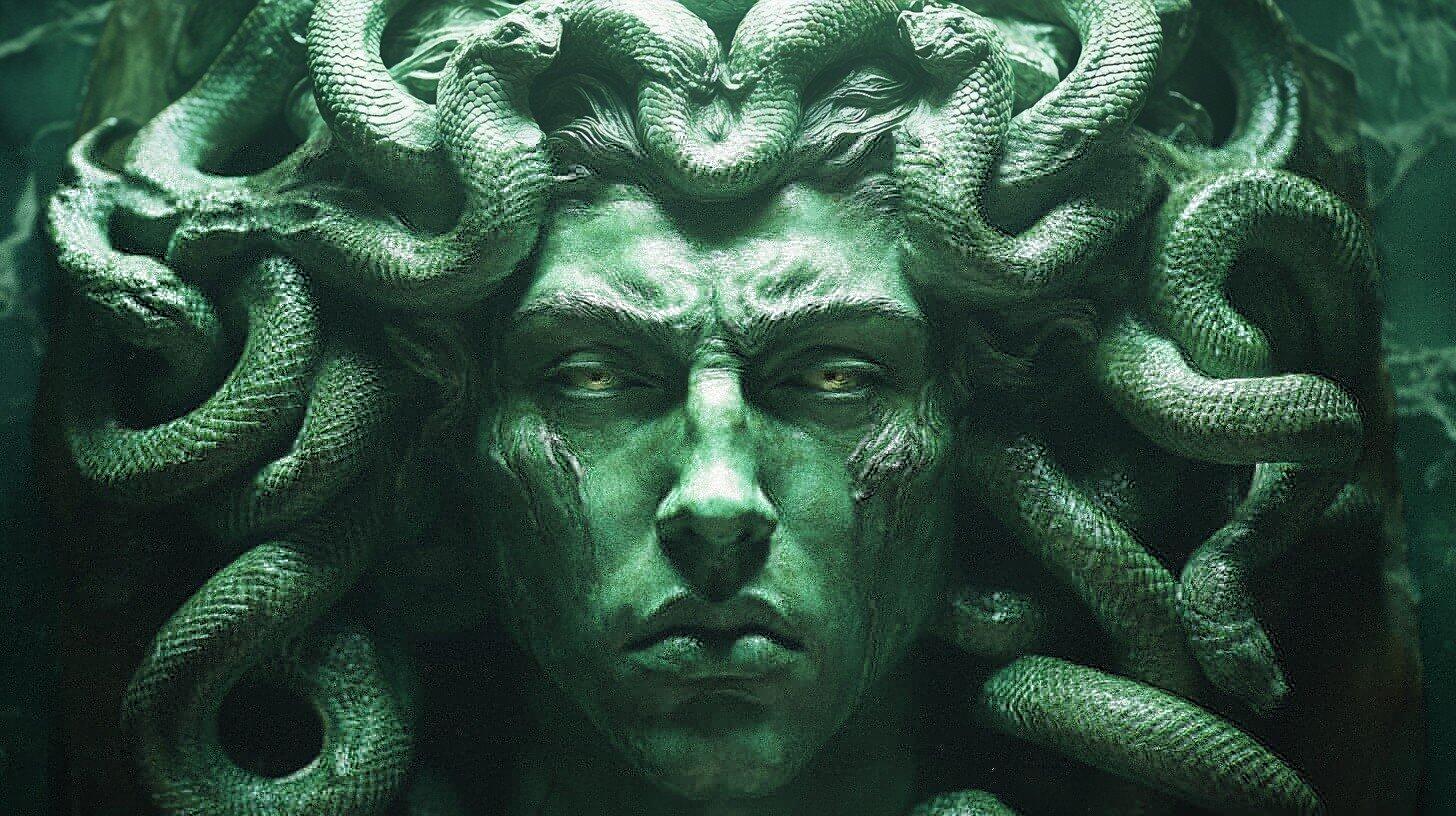Greek mythology is renowned for its vast collection of mythical beings, ranging from formidable monsters like the Minotaur to enchanting creatures like the Sirens. These entities often symbolize various aspects of human nature, natural phenomena or cultural values, serving as both obstacles and aids to heroes in their epic quests.
Greek mythology monsters can be classified according to their form, function and role. This organization helps us understand their symbolism and role in the stories:
| Category | Example | Description | Symbolism | ||||
|---|---|---|---|---|---|---|---|
| Monstrous Beasts | Minotaur | Human body with bull head; lives in Labyrinth | Represents irrationality and inner chaos | ||||
| Monstrous Beasts | Hydra | Multi-headed serpent from Lerna; poisonous and regenerating | Symbol of persistent problems and strategic struggle | ||||
| Monstrous Beasts | Chimera | Lion head, snake tail; fire-breathing | Represents hybrid dangers and irreconcilable forces | ||||
| Hybrid Creatures | Centaurs | Half-human, half-horse beings; often wild | Symbol of human reason vs. animal instincts | ||||
| Hybrid Creatures | Satyrs | Nature spirits with animal traits; companions of Dionysus | Represent festivity, lust and lack of control | ||||
| Hybrid Creatures | Sphinx | Female head, lion body, wings; asks riddles | Symbol of wisdom and intellect | ||||
| Divine & Magical Animals | Pegasus | Immortal winged horse born from Medusa’s blood | Symbol of inspiration and link between human and divine | ||||
| Divine & Magical Animals | Cerberus | Three-headed dog guarding the Underworld | Represents the boundary between life and death | ||||
| Divine & Magical Animals | Phoenix | Bird reborn from ashes after burning | Symbol of renewal, immortality and eternity |

Monstrous beasts
These include creatures of great size and power, usually hybrid or deformed, representing uncontrolled forces of nature or challenges for heroes. Great examples of Greek mythology monsters are the Minotaur, Hydra and Chimera. Below are some of the most famous beasts, with descriptions and some cool facts about their legends:
Minotaur
A hybrid being. It has the body of a muscular, adult man, but instead of a human head, it has the head of a bull, with prominent horns, a snout and bovine features. Some versions describe this creature as having a reverse bovine body and a human head; however, it is traditionally represented as described in its original description.
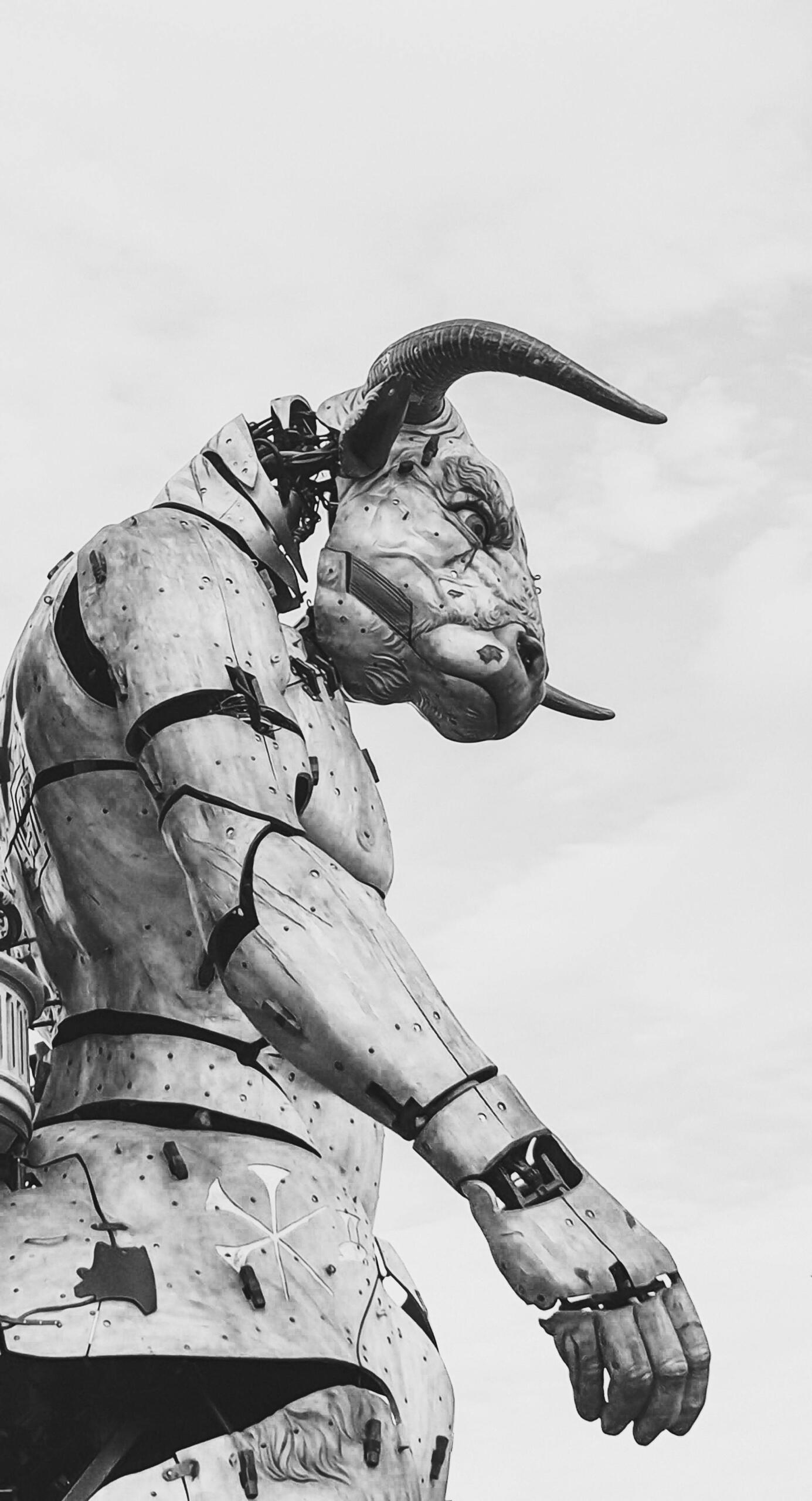
The Minotaur originated from a forced union between Queen Pasiphae and a bull sent by Poseidon, as a result of the divine punishment imposed on King Minos of Crete, who pretty much failed to sacrifice it.
As a consequence, Minos built the Labyrinth at Knossos to control it. With twisting corridors and hidden corners, the design of the labyrinth was too complex. The Minotaur was fed on children, sacrificed as a tribute from Athens to calm his hunger.
According to the ancient myth, the hero Theseus reached the labyrinth and defeated the monster by strangling or fighting him hand-to-hand. 1
It represents irrationality, the inner beast within human beings and dark forces that must be overcome. Some modern interpretations associate the Minotaur with earthquakes or ideas of underground chaos.
Hydra
The Hydra lived in the marshes of Lerna, a place considered the gateway to the underworld. With poisonous breath and blood, Hydra was a terrible entity, and even the exhalation of its breath could be deadly. And plot twist, one of its heads was immortal and could not be killed by ordinary means.
One of the most famous episodes featuring the Hydra is the Twelve Labors of Heracles, as his second mission was to decapitate the Hydra. Heracles cut off one head after another, but each section generated two new heads, which made it almost impossible to defeat it.
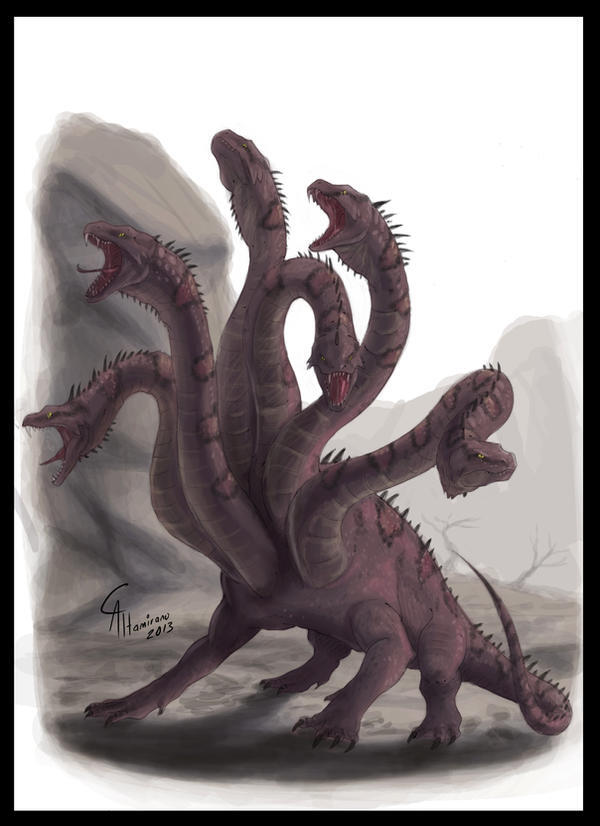
To solve this, his nephew Lolaus helped him by applying fire to the freshly severed stumps to cauterize them, preventing their regeneration. In some versions, the immortal head was cut off with a golden sword and then buried beneath a rock. 2
The Hydra can represent the challenge of dealing with persistent problems. However, its myth also suggests that heroic struggle must combine strength, intelligence and strategy.
In many myth versions, Hydra has nine heads, although the number varies according to the literary source.
Chimera
A hybrid monster composed of parts of different animals in a single body. In its most accepted traditional form, it has the front and head of a lion, the head or bust of a goat on its back and a tail shaped like a snake (sometimes with a snake's head). Some representations add wings or the ability to spit fire.
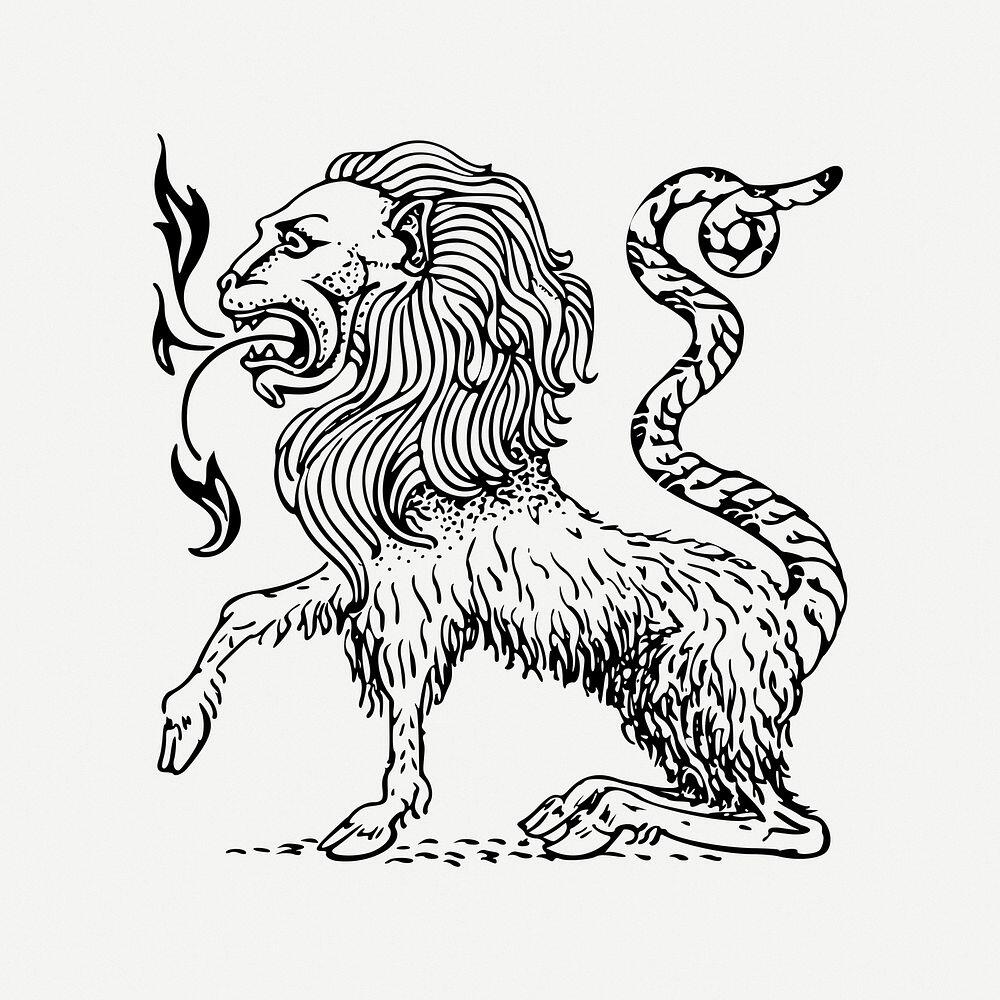
The Chimera is the daughter of Typhon (a gigantic being) and Echidna (The Mother of Monsters), thereby placing her among the most notorious beasts of the mythological universe. She is also the sister of Hydra, Cerberus and Ortro.
The main myth places her dwelling in Lycia (Asia Minor). Since the Chimera was a bit chaotic and dangerous, she devastated the region with her fiery breath and her pretty much deadly combination of beasts. To fight her, Bellerophon, who was the Greek hero who tamed Pegasus, attacked her from the sky. In some versions, he killed her by driving a molten lead stake through her body, melting her organs.3
It represents the dangers from multiple sources, the mixture of irreconcilable elements, and the monstrosity of the hybrid. This Greek mythology monster has inspired the metaphor of the chimerical, or something illusory and impossible to achieve.
Hybrid Creatures
Beings that combine human characteristics and animal elements. Centaurs, satyrs and the sphinx are among the hybrid creatures, each with specific symbolism that reflects the duality of human nature.
Centaurs
Wild and drunken Greek mythology creatures with a human torso from the waist up and a horse's body from the waist down. This anatomical structure places them between the duality of human and animal. They have an ambiguous genetic origin. Some claim that they were born from the union between Ixion and Nephele (a cloud in the shape of Hera), which places them as descendants of the divine and the human. 3
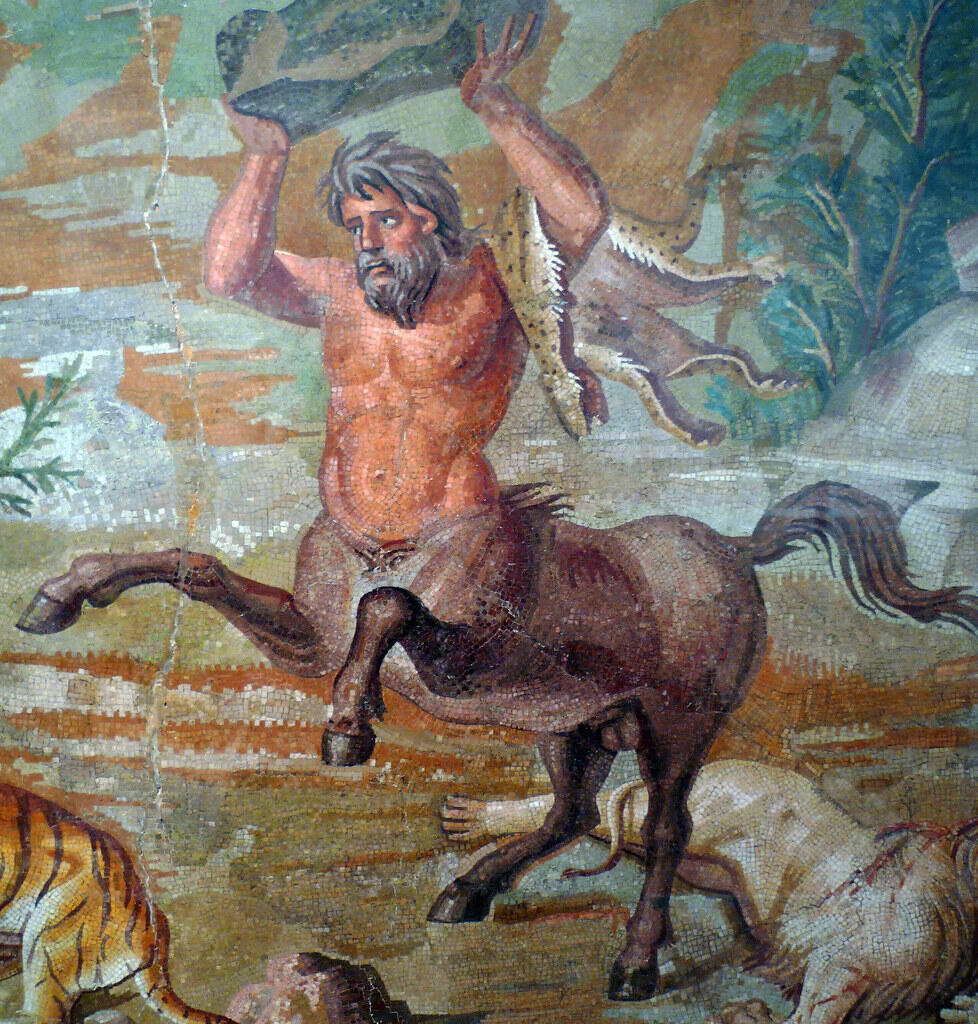
Centaurs are beings that possess human reason, but are dominated by instinctive passions. The most famous example is Chiron, who stands out for his wisdom, his mastery of the medical arts, and the education of heroes, in contrast to the majority of the group, who are characterized by being drunk, violent and savage.
One of the myths, in which Heracles also appears, is The Twelve Labors. While visiting his centaur friend Pholus, Heracles opened a sacred wine and attracted other centaurs who attacked him. As expected, Heracles killed way too many of them, but accidentally struck his teacher Chiron with a poisonous arrow. Since Chiron was immortal, the poisoned wound caused him endless suffering until he had to give up his immortality to be free from pain. 4
Centaurs symbolize the duality between civilization and savagery, between rationality and animal instincts, and show the internal moral conflicts.
Satyrs
Nature demons with mixed characteristics. In various representations, they are attributed horse or donkey ears and tails, faces with bestial features, or human or partially animal legs. Linked to Dionysus, the Satyrs participate in the Dionysian festivities, drinking wine, dancing and playing instruments. 5
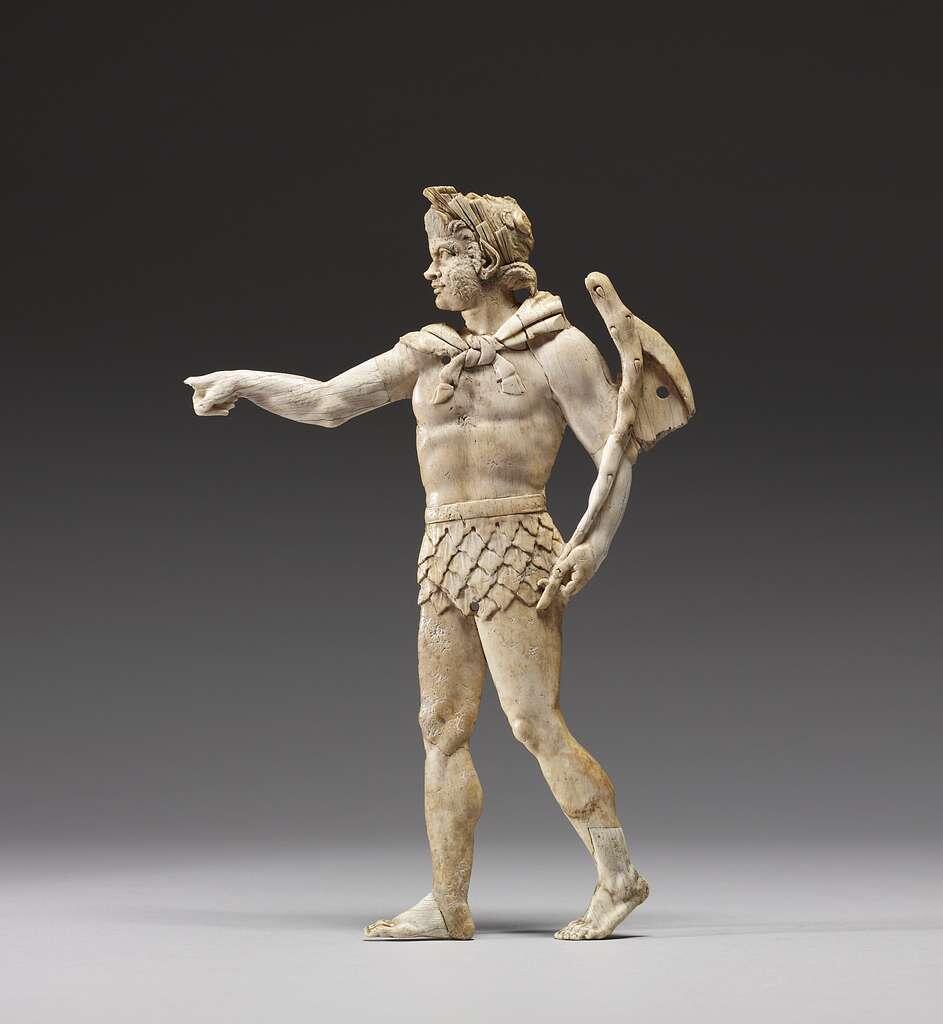
However, as they are not benevolent beings, their character is lustful, uncontrolled and way too unpredictable. They pursue nymphs or mortal women to seduce them, although they usually fail.
A myth involving the Satyrs tells the story of Marsyas, who challenges Apollo to a musical contest. After losing, Apollo condemns him to extreme punishment through flaying. This shows the dangerous line between mortal audacity and pride in the face of the divine. 6
Over time, the iconography of satyrs evolved: in later times, they acquired more goat-like features (goat's feet, horns) under the influence of the fusion with the Roman "fauns". Satyrs represent the free instincts of nature, the connection with the wild, the festive, and the excesses.
Sphinx
Greek mythology monster with a female human head, the body of a lion and bird wings. Described as a guardian of sacred places who challenges travelers with tricky riddles that must be solved correctly; if not, they are devoured.
The most famous is the story of the King of Thebes, Oedipus. It asked: Which creature walks on four legs in the morning, two legs at noon and three legs in the evening? (answer = Man). When answered correctly, she threw herself off a cliff and set the city free from her oppression. 7
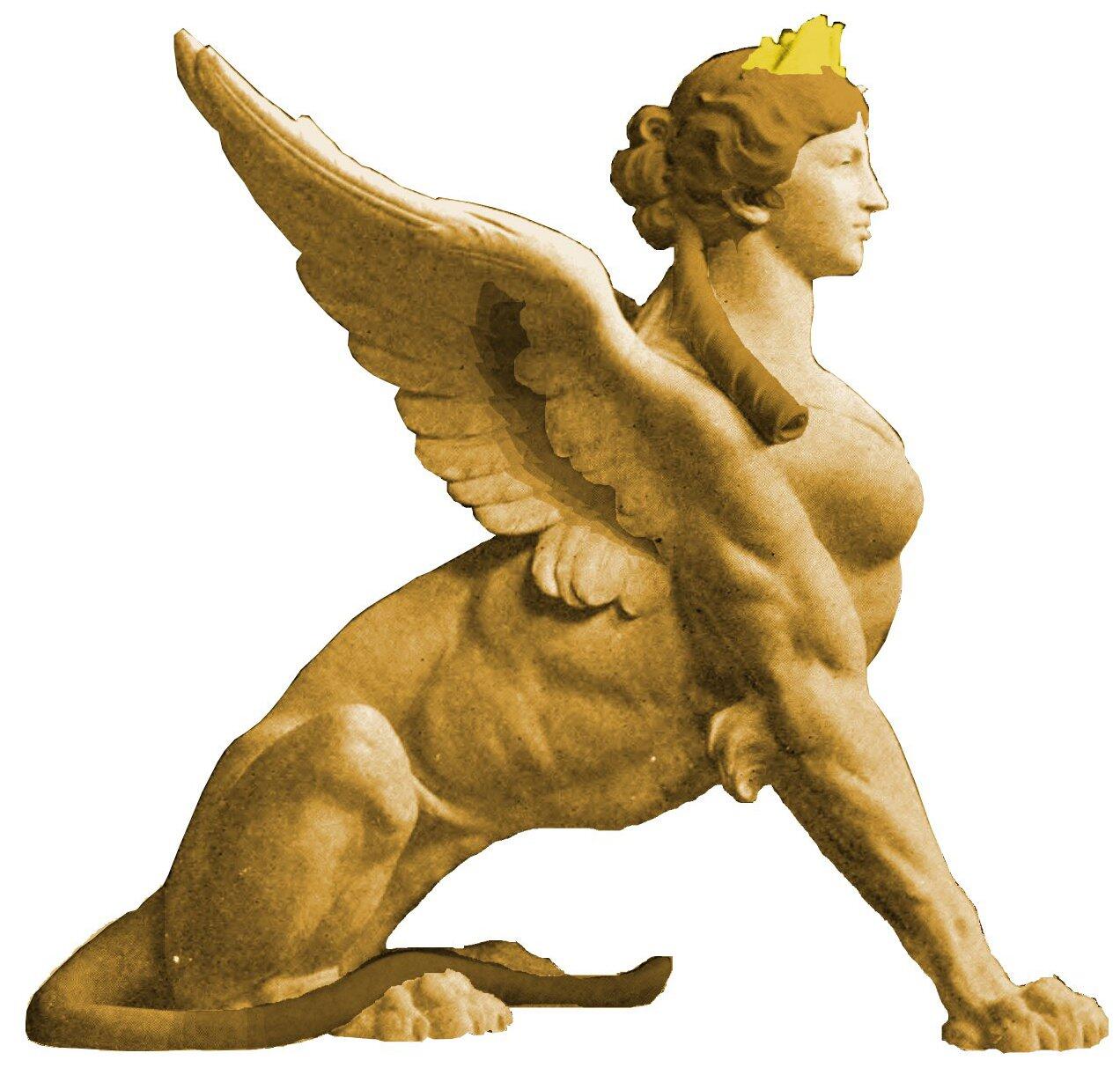
The Sphinx represents a dual role: Both guardian of knowledge and intellect. Her presence is a proof that the hero must demonstrate wisdom and strength to survive any adversity. She symbolizes the mortal and the divine, as well as the need for men to overcome inner riddles and contradictions.

Divine and Magical Animals
Greek mythology animals that have a protective role and are considered a loyal companion of heroes, deities and guardians, such as the celestial horse, Pegasus; the dog with three heads, Cerberus; and the Phoenix, the immortal bird of resurrection.
Pegasus
Well known as a Disney character, it is an immortal winged horse that emerged when Perseus decapitated Medusa, following the decapitation, Pegasus and his brother Chrysaor sprang from her blood.
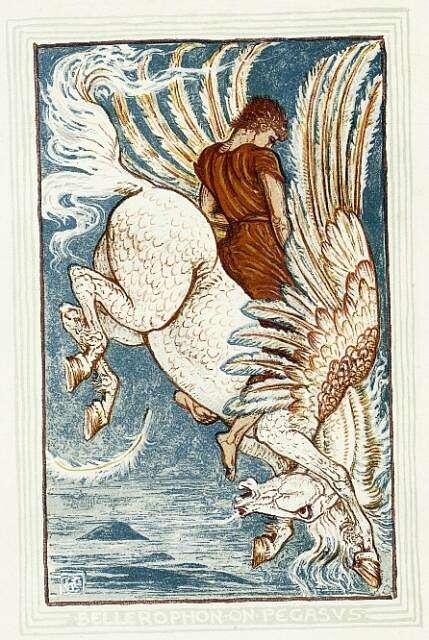
It has large wings that allow it to soar through the skies with elegance and speed. In many characterizations, his coat is pure white and his wings are broad.
Bellerophon tamed Pegasus with the help of a divine bridle and used him to fight monsters. At one point, Bellerophon attempted to climb Mount Olympus riding him, but Zeus repulsed him by sending him a sting, knocking him down. Pegasus continued his service by carrying Zeus' thunderbolts. 8
He symbolizes elevation, poetic inspiration and the bridge between earth and heaven. A mediator between the human and divine.
Cerberus
Gigantic dog with several heads (usually three) that guards the door to the underworld, preventing the dead from leaving and the living from entering. In addition to his multiple heads, in some versions, he has a snake tail, a mane of snakes and powerful claws.
He is considered the son of Typhon and Echidna, which places him among the monstrous guardians of the divine and subterranean worlds.
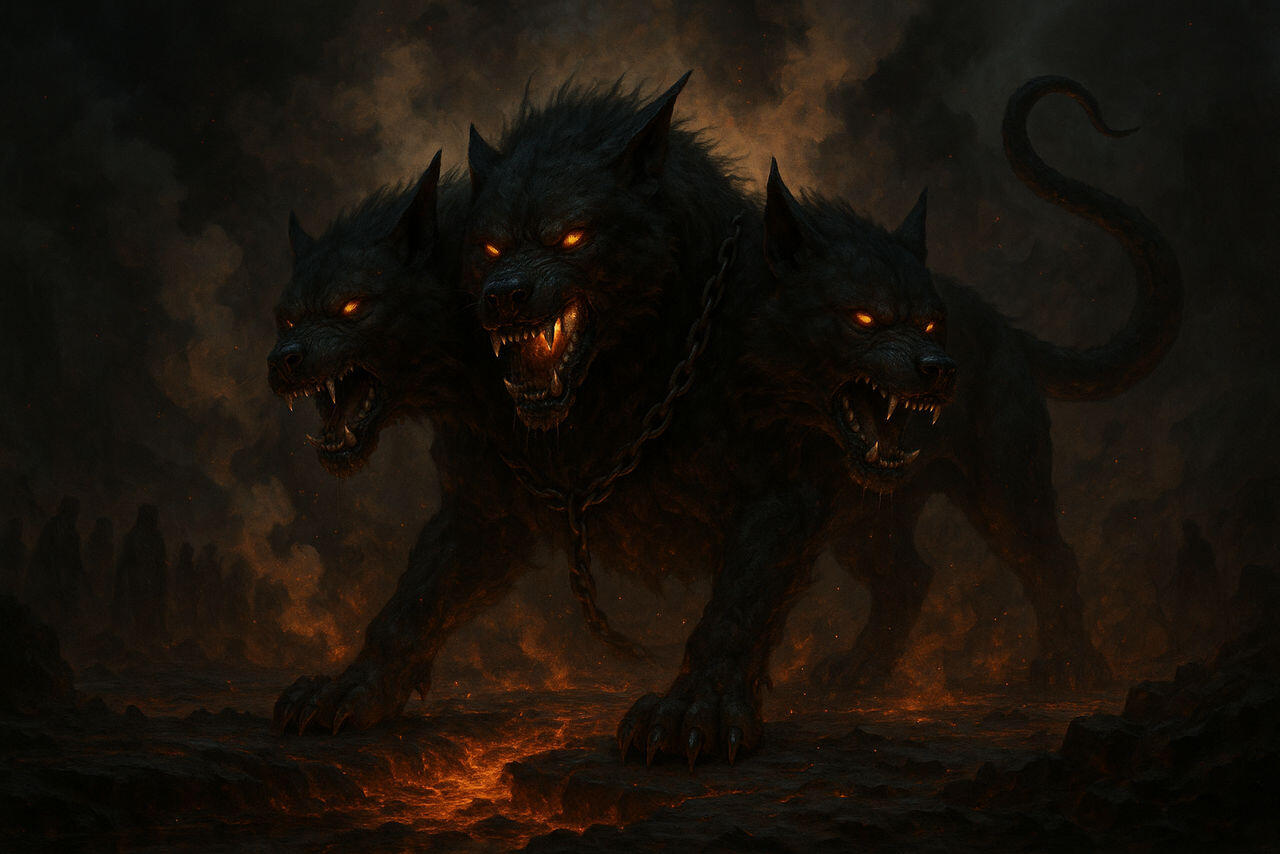
In the myth of Heracles, one of his deadly twelve tasks is to capture him. Heracles manages to defeat him and then returns him to the underworld. Cerberus represents the barrier between life and death, the frontier that separates the mortal from the eternal.9
Phoenix
It is described as a majestic bird, characterized by bright colored plumage and a long tail. Every time it dies, the bird is consumed by flames and is later reborn from its ashes as a new phoenix.
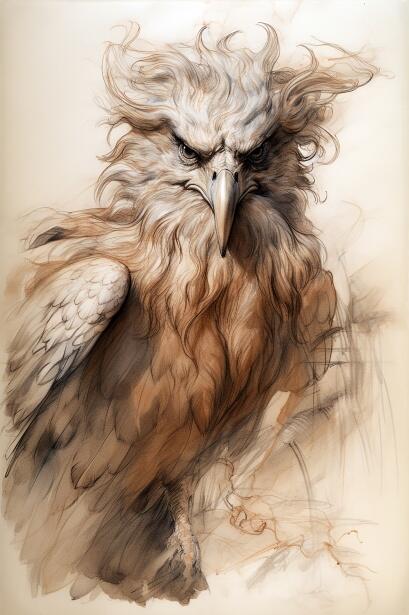
The phoenix is the ideal metaphor for renewal, continuity and eternity in the late Greco-Roman literature. As a mythical symbol, the lovely phoenix represents the ability to regenerate, to rise renewed from destruction and the transcendence of all temporal limitations.
Although not originally Greek, it was adopted by Hellenistic writers as a symbol of immortality. 10
All these fantastic animals can possess traits from multiple categories and receive mixed interpretations, depending on the literary source and tradition. These classifications are somewhat flexible and facilitate the identification of these mythological beings and their representation within Greek mythology.
Would you like to learn more? Visit Theoi Greek Mythology for more detailed information.
Roles and Symbolism of Mythical Beings
Challenges to Heroes
In Greek mythology, many mythical creatures represent tough obstacles that heroes must overcome to demonstrate their bravery and strength, and basically to survive.
A great example is the Minotaur, locked in the Labyrinth of Crete, represents a physical and intellectual challenge: Theseus not only had to confront the monster but also find a way out of the labyrinth.
It is a challenge that shows the impossibility of solving specific problems through brute force. Each severed head generated new ones, which forced Heracles to resort to the strategy of cauterizing the wounds with the help of Yolaos.
This episode highlights the value of collaboration and tactical intelligence, while also demonstrating that the heroes had to confront evils that regenerated and persisted, symbolizing the recurring obstacles in human life.
Protectors and Guardians
Other mythical beings are guardians of sacred spaces or frontiers between heaven and hell. For example, Cerberus, the three-headed dog, guarded the gates of the underworld, preventing the living from entering and the souls of the dead from escaping.
His image represents the transition between life and death and symbolizes the impossibility of altering the natural order of the cosmos.
Another great example is the sphinx, who guarded the entrances to Thebes by posing deadly riddles. Its function was not only physical, but also intellectual: it forced the hero to demonstrate his reasoning ability to pass the test to avoid being eaten.
Oedipus's correct answer to the riddle is the plot twist, revealing how mythological guardians also demanded wisdom.
Symbols of Natural and Cultural Phenomena
Some monsters also represent abstract concepts and cultural phenomena. The phoenix symbolizes renewal and immortality. According to some versions, this bird burned at the end of its life cycle and was reborn from its own ashes, representing regeneration after destruction - Greek and Roman writers used this symbol to illustrate the continuity of nature and the desperate hope of immortality.
Beyond the fantastic phoenix, many mythological monsters also reflected natural phenomena: The hydra as the uncontrollable multiplicity of the swamps of Lerna, the Chimera as an allegory of the volcanic activity of Lycia, or Pegasus as a symbol of the movement of celestial waters. 11
These myths not only offer mythical explanations of the physical world but also cultural and pretty shocking ethical lessons for the readers.
Influence on Modern Culture
Literature and Art
In contemporary literature and visual arts, Greek mythological literature continues to be source of inspiration, reinterpretation and symbolism.
In modern painting and contemporary art, figures such as the Minotaur have been reinterpreted in multiple artistic styles. For example, the celebrated Pablo Picasso produced engravings entitled Minotauromaquia in which the Minotaur appears as a personal and emotional connotation, connected to his biography and historical context.
In modern literature and fiction, Greek monsters appear literally and symbolically. In some fantasy novels and young adult novels, the Minotaur reappears as a creature guardian of physical or psychological labyrinths. In contemporary works, this famous labyrinth may be represented as mental structures or internal traumas. Indeed, some critics see echoes of the Minotaur's labyrinth in the maze trials of The Hunger Games movies.
The visual arts also use them as symbols of inner struggle. For example, the figure of the gorgon or the snake may appear as a decorative motif, mural, or in comic book illustrations that explore the feminine or the fearsome. Modern literature and art are massively inspired by these ancient myths, not as literal copies, but as a dialogue with the present: Greek mythology creatures that function as metaphors, characters charged with symbolisms and fascinating aesthetic decor.
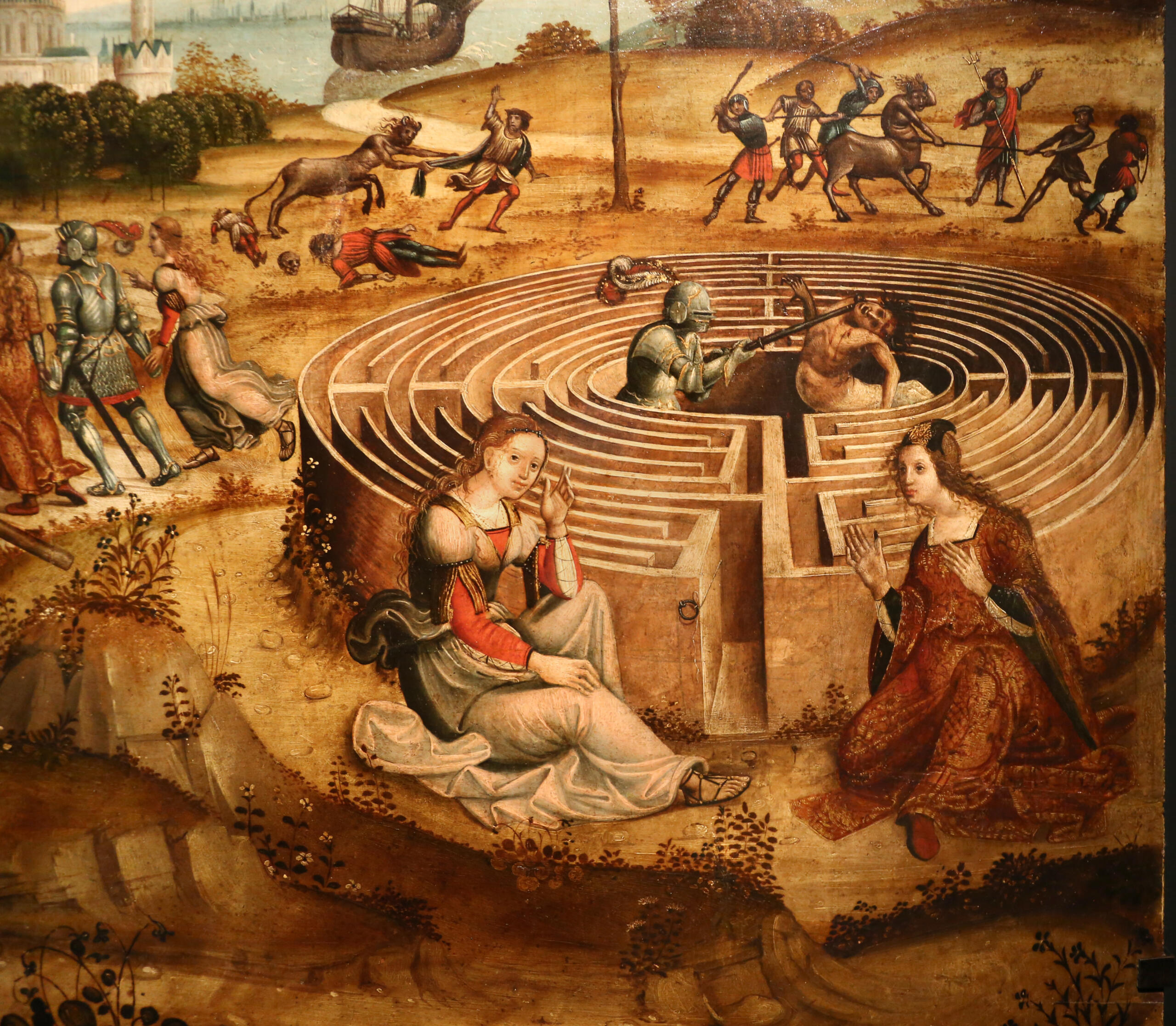
Popular Media
Movies, television and video games draw on our favorite Greek mythology creatures to capture the imagination, endowing them with dynamic visual characterization, narrative plots and interesting reinterpretations.
Some cool adaptations or inspirations of Greek myths are pretty popular in film and television. Productions such as Fury of the Titans, Hercules, Jason and the Argonauts, The Odyssey and Troy include mythical deities and supernatural beings to generate fantastic action.
When it comes to video games, Greek mythology has served as a background world, setting and inspiration for mechanics. The God of War series, for example, integrates Greco-Roman gods and monsters into its combat and narrative. Independent games also incorporate mythical creatures as enemies or allies. In Apotheon, an action game with Greek aesthetics, mythological monsters act as obstacles.
More recently, the video game Hades II continues the tradition of mixing mythology and modern action, introducing mythological creatures adapted to contemporary roguelike game design and interactive narratives.
Greek mythology creatures and deities are also reused in fantasy and superhero series: hybrid creatures, underworld monsters and fantastic beings often reappear as epic antagonists.
References
- The Editors of Encyclopaedia Britannica. (2025b, August 27). Minotaur | Definition, Story, Labyrinth, & Facts. Encyclopedia Britannica. https://www.britannica.com/topic/Minotaur
- Adkins, A.W.H., Pollard, & Thornhill, J. R. (2025, August 26). Greek mythology | Gods, Goddesses, Stories, Names, & History. Encyclopedia Britannica. https://www.britannica.com/topic/Greek-mythology
- Chaliakopoulos, A. (n.d.). Where did the Centaurs come from? A journey through ancient art | TheCollector. TheCollector. https://www.thecollector.com/centaur-in-greek-art/
- Apollodorus, Library, book 2, chapter 5, section 4. (n.d.). https://www.perseus.tufts.edu/hopper/text?doc=Apollod.%202.5.4&lang=original
- Cartwright, M., & Cartwright, M. (2023). Satyr. World History Encyclopedia. https://www.worldhistory.org/satyr/
- Apollodorus, Library, book 1, chapter 4, section 2. (n.d.). https://www.perseus.tufts.edu/hopper/text?doc=Apollod.+1.4.2
- SPHINX - Woman-Headed Lion of Greek Mythology. (n.d.-b). https://www.theoi.com/Ther/Sphinx.html
- PEGASUS (Pegasos) - winged horse of Greek mythology. (n.d.). https://www.theoi.com/Ther/HipposPegasos.html
- The Editors of Encyclopaedia Britannica. (2025c, September 26). Cerberus | Mythology & Facts. Encyclopedia Britannica. https://www.britannica.com/topic/Cerberus
- The Editors of Encyclopaedia Britannica. (2025d, October 3). Phoenix | Egyptian, Greek & Roman. Encyclopedia Britannica. https://www.britannica.com/topic/phoenix-mythological-bird
- Pollard, Thornhill, J. R., Adkins, & A.W.H. (2025b, August 26). Greek mythology | Gods, Goddesses, Stories, Names, & History. Encyclopedia Britannica. https://www.britannica.com/topic/Greek-mythology

